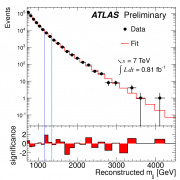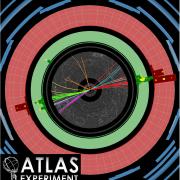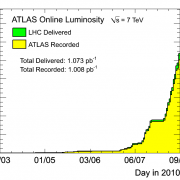Access to Collaboration Site and Physics Results
(I'm not skipping day 2, about heavy flavors and my own talk, but I think today's topic merits a reshuffling)
It is no secret that Moriond EW 2012 celebrates the year of the "Higgs". In December both CMS and ATLAS published preliminary results with the intention to present more complete analyses at this year's Moriond, now the time has come at last.
Results aplenty: D0, CDF, CMS and ATLAS all presented limits consistent with "something" (*) around 120-130 GeV.
The plots below show upper limits on the Higgs mass from ATLAS and CMS. If you don't know how to read one of these plots (I don't blame you!) there is an excellent explanation on the ATLAS public site and in the Quantum Diaries.
The basic message is that if a Higgs particle exists we will see a peak, measured by the distance between the filled black line and the dashed line with green and yellow bands around it, that grows larger at a specific mass as we gather more data.

Now, to the meat. The Higgs, or the scalar boson, as it is referred to at the moment. Is excluded for all masses up to around 600 GeV, except in the region around 120 to 130 GeV. What that indicates is that if the particle exists it is likely to be in that range. Now, why the vague language? In particle physics everything is statistics. We can see fluctuations in our data that can look like interesting physics; to avoid reading too much into these effect, we are fairly conservative when we see deviations from the standard model. What we require to claim a discovery is that we are 99.9999% sure that the "particle" is not a statistical fluctuation of the Standard Model playing tricks on us. With what we see at the moment we are over 95% confident but that still leaves room for error.
What is interesting is that both ATLAS and CMS see the same thing. Also the Tevatron experiments are in as much agreement as they can be with their available statistics. So it all looks like something at 125 GeV. Before the summer we are likely to know for sure. When the LHC starts in a few weeks time, it will "ramp" to 8 TeV. This slight increase in energy makes the possibility to see Higgs particles slightly higher and allows the accelerator to collide more particles per second than at 7 TeV.
With interesting results like these on the horizon, people are smelling a Nobel Prize. Will it go to Peter Higgs, his predecessors that originally described the electroweak symmetry breaking or perhaps the experiment(s) that discover(s) the particle? At the moment a lot of "positioning" is taking place to try and figure out who is responsible for this (potential) discovery. Semi-jokingly all the presentations feature titles like "SM Scalar boson" or "BEH Scalar boson" for Brout-Englert-Higgs to underline that the popular name is not necessarily describing the original creator. Hopefully it will be given to those deserving it with a nod towards the rest of the contributors, this is a large scale project after all, both experimentally and theoretically. What I find more worrying is that if the name sticks, we will have a fundamental particle named after a person, that seems somewhat odd compared to the rest of the Standard Model particles.
All in all a very exciting day, with a lot of discussion and emotion all around.
(*) I'm not a Higgs researcher and the opinions stated above do not necessarily represent the opinions of the ATLAS Collaboration.









